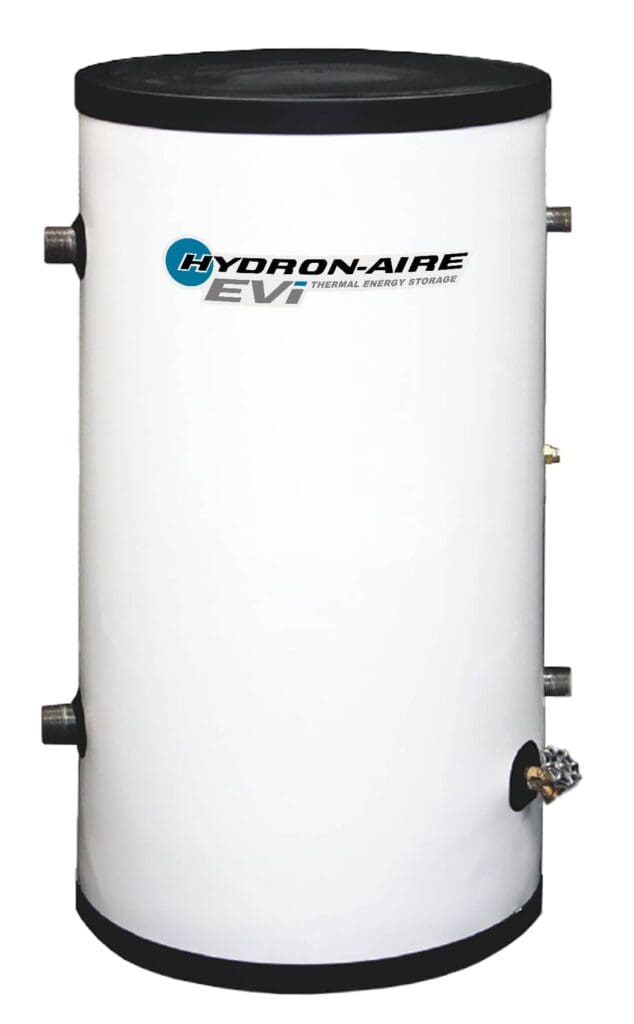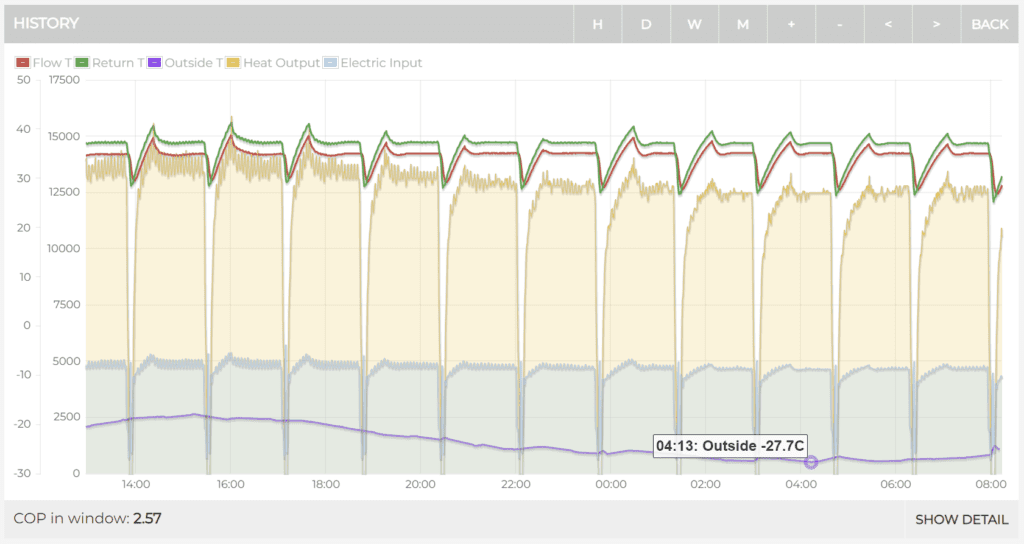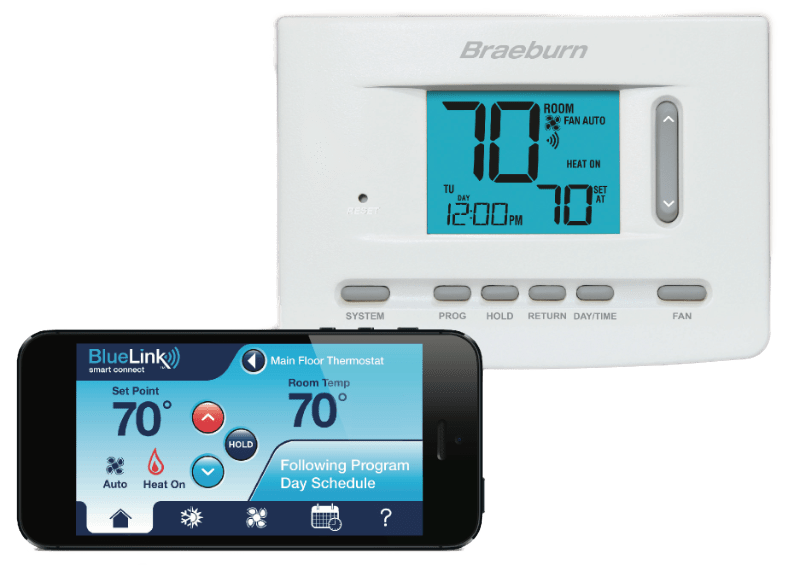EVI – Enhanced Vapor Injection
EVI is a technology used on our cold climate heat pumps to achieve higher performance at lower temperatures. An EVI heat pump uses a 3rd smaller internal plate heat exchanger called an “Economizer” within the refrigeration cycle to provide optimal refrigerant pressures and temperatures to a twin inlet compressor. These features allow the heat pump to efficiently and reliably extract energy from much colder air than standard heat pumps.
With the right control system, multiple comfort zones can be serviced within a home or building.
Heat pumps are a proven, environmentally friendly technology that saves energy and money. However, traditional air-to-air and air-to-water heat pumps cannot efficiently extract energy from winter air conditions. When you need the most heat, they give you the least and at their worst efficiency. That’s where Hydron-Aire EVI steps in!
EVI technology allows our heat pumps to maintain high efficiency and capacity down to -30C air temperatures.
In addition, an air-to-water heat pump can be used to heat domestic water. A dedicated heat exchanger or hot water tank with a built-in heat exchanger is used to transfer heat from the heat pump system to heat domestic hot water. We even offer specific models for pools and hot tubs.

Advantages of EVI
- Government incentives.
Check with your local provincial and municipal governments as well as energy providers to see what incentives may be available in your area. We cover provincial rebates in our news section as well! - Electric backup is available.
You can choose to have an electric form of backup heat, depending on what type of system you have. For example, our thermal storage tank comes with 12 kw of backup heating elements to keep the water hot in case the heat pump stops operating. If you have an air handling unit for air distribution, you may also add in an electric backup heater to keep the air hot. - It’s not very loud.
The outdoor heat pump can range from approximately 43 dB to 48 dB, depending on the size of the heat pump. - It has a defrosting cycle.
A defrost cycle removes the frost from the outdoor coil. Frost conditions will occur when the coil temperature is lower than the dew point of the outdoor ambient air. The defrost cycle should be long enough to melt the ice, but short enough to be energy efficient. The defrost cycle on our heat pumps lasts only a few minutes because we can use the stored heat of the water in the storage tank to accelerate the process. Because of this stored energy, the system’s efficiency is improved compared to traditional outdoor heat pumps. - We are certified by TÜV Rheinland, which stands for safety and quality in virtually all areas of business and life. Founded almost 150 years ago, the company is one of the world’s leading testing service providers.
- Our heat pump comes with a 5-year parts warranty.
The EVI System
EVI stands for “Enhanced Vapor Injection” and is a technology used on our cold climate heat pumps to achieve higher performance at lower temperatures. An EVI heat pump uses a 3rd smaller internal plate heat exchanger called an “Economizer” within the refrigeration cycle to provide optimal refrigerant pressures and temperatures to a twin inlet compressor. These features allow the heatpump to efficiently and reliably extract energy from much colder air than standard heat pumps.
With the right control system, multiple comfort zones can be serviced within a home or building.
In addition, an air-to-water heat pump can be used to heat domestic water. A dedicated heat exchanger or hot water tank with a built-in heat exchanger is used to transfer heat from the heat pump system to heat domestic hot water. We even offer specific models for pools and hot tubs.
Our air-to-water heat pump can operate at outdoor ambient temperatures of -30 C (-22 F).

A reliable technology
Our EVI heat pumps continually monitor the compressors operating conditions and varies the speed and refrigerant flow through electronic expansion valves to keep it in its safe operating window. In extreme conditions, the heat pump artificially increases the cooling sent to the compressor’s electric motor using a refrigerant-to-refrigerant heat exchanger. These strategies and components have been used for decades in our large commercial variable speed equipment and are proven reliable solutions.
How does EVI work?
The EVI technology allows our heat pumps to operate efficiently down to much lower outdoor temperatures than standard heat pumps. To do this it utilizes a refrigeration compressor with two suction inlets instead of one. In low temperatures, a portion of refrigerant gas is reinjected into the second compressor connection to lower the total pressure difference the compressor must work against. The compressor is then sped up to do the same total work thus maintaining heating capacity.
To illustrate we can compare a heat pump to a vehicle. For example, a truck may be used to pull a load of material up a hill. The heavier load you want to move up the hill the more powerful engine you need. But the more powerful engine will take more energy to operate even when the extra power is not needed. Ideally, when the hill is steep, you simply reduce the amount you pull but make more trips to get the job done. Then you can drive a truck with a smaller and more efficient engine year-round, saving you money.
A heat pump does the same thing by moving heat energy from a low-temperature location to a higher temperature location. The heat pump compressor has to be sized to operate efficiently during low load conditions. But when the difference between the outdoor and indoor temperature is high, traditional heat pump compressors will have insufficient power to get the job done. EVI technology allows the compressor to pull less energy up the hill per cycle and work faster, thus maintaining heat output.
Efficiency at very low temperatures
These graphs illustrate the heat pump running at a cold temperate and the efficiency it achieves



Components
There are a few different air to water heat pump system configurations a homeowner could choose from, but typically you would expect to have the outdoor air to water heat pump, water circulation pumps, storage tanks and a control system or thermostat. If there is a forced air component to the system, then an air handler would be required as well.
Basic heating and cooling applications can make use of a simple onboard control or remote mounted thermostat while multizone systems use a central zone controller with remote thermostats in each zone.
Maintenance and service
Depending on the needed service, certain skilled trades may be required to perform the task. A refrigeration mechanic would be needed to service any part of the refrigeration system while a plumber could repair leaks to water lines. An electrician may be required for any electrical servicing. Fortunately, most mechanical service companies employ all these trades so it wouldn’t be hard to get assistance.
Like most heating and cooling systems, a seasonal check-up is required. The outdoor heat pump needs to be inspected for dirt and debris blocking the fans and coil which can affect the efficiency of the unit. The outdoor unit should also be checked annually for refrigerant levels and pressure. Inside the home, there may be air filters or water filters that need changing. Additional maintenance may be suggested by the installer depending on the system application for your home or building.
An air to water heat pump can last up to 20 years or longer if properly maintained. External factors such as install location and local climate can have a bearing on the heat pumps life span.
We stock almost all replacement parts at our warehouse in Manitoba, Canada.
Installation
Like any comfort system, the heat loss of the home or building is calculated. Once the heating and cooling requirements are determined, a system can be selected to meet those needs.
Depending on the application and complexity of the system design, the installation process can range from 1 to 3 days.
